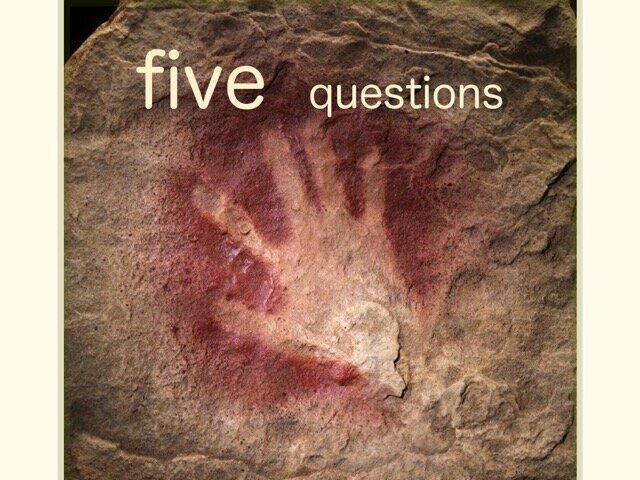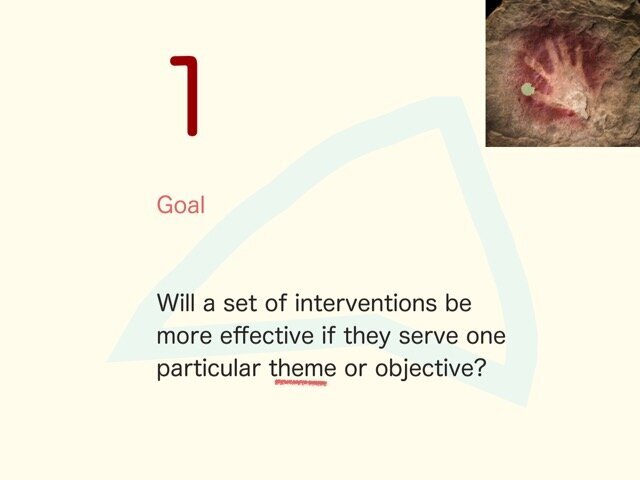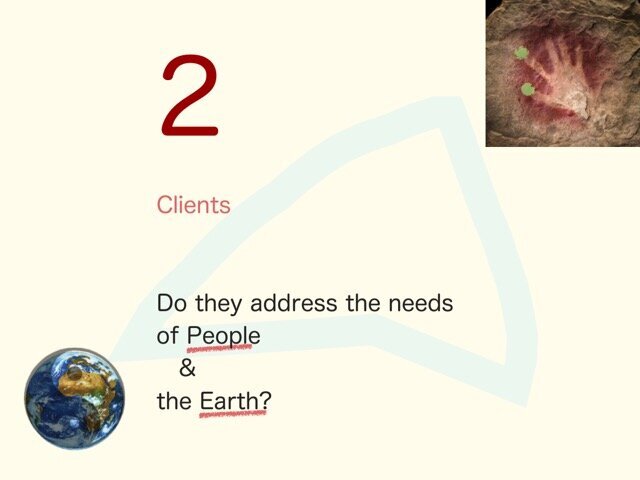five questions
People often ask for examples of how to think in terms of art systems. On this site, I’ve been most focused on systems people could actually bring home. The idea of a grouping of elements working together, however, can be independent of scale. The grouping thing is the systems concept – the scale issue is about strategy.
I came up with this list of questions several years ago. It’s a handy (✌) way to approach this idea. I like to use my hand as a mnemonic to keep track of the different elements. I memorize numbers that way too. I’ve seen farmers in rural areas use their hands and bodies to give directions and explain things. Teacher friends use similar techniques in grade school now when teaching songs. It’s kind of fun. (Note: those of you good at math might notice I’m not counting the first question below which starts the handful.)
What might the components of an art or articultural system look like?
(I often hold my hand up as I go through each point.)
This image from the caves of Lascaux reminds me of how ancient these issues are. Is this particular hand stencil inside a cave part of an “art system”? I have no idea, but I wouldn’t be surprised if it was created as part of a larger ceremony with people wearing sacred clothing symbolic skin markings, accompanied by song, sculptural objects, prayer and deeply connected to a sense of place and these people’s understanding of their ties with each other and the beings and energies around them.
We are used to seeing images like this one completely out of context and of course, can only imagine what Paleolithic lives were like. From what I understand from contemporary indigenous people and their relationship with ancient petroglyphs or markings in sacred sites where they live, it’s pretty complex and integrated with other forms of deep cultural expression, history, and ecological stewardship in ways that an identical image on the wall of a gallery or museum might never be.)
First question:
is there a unifying purpose or GOAL in mind?
The world is rich in complexity but it helps sometimes to have a plan. What community issue or concern might be important to address? Is there some ecological problem (or treasure?) you’d like to focus your attention on? You might find that identifying one theme allows you to connect with other related issues as well. What feels right and might inspire the most impact or support?
(Note how the thumb in the image is highlighted. Once you have a “thumbs up” you’re ready to move to the next question. And yes, these tips are silly but they help me remember this stuff.)
Second question:
is about who all of this is for…
This is a classic feature of ecological art in general and I’d argue it makes sense to consider for everything we do. As human beings alive on the Earth, all our actions and non-actions have an impact. When it comes to art, most people think principally, if not exclusively, about the human audience. Religious people might add God to this and in the past, this spiritual dimension was often at the forefront. Non-human impacts (such as on other species, ecosystems, and the Earth), however, are frequently overlooked. I use the word “client” here but you could just as easily replace it with “audience” or “beneficiary” or any other such word. A hundred people might feel moved by a painting of a clearcut forest but thousands of people and an entire watershed’s worth of creatures for generations might be impacted by the toxic cadmium mine tailings, petrochemicals, and industrial infrastructure supported (even in a small way) by the artist’s choice to use an “affordable” dab of a particularly beautiful shade of yellow. The same goes with the ecological footprint of making, displaying, and preservation (or disposal if that’s part of the mindset) of any work of art- sculpture, dance, theater, etc.
It’s complex. What is the true cost/benefit of an artwork, an image, a website, one’s life? It’s important to note that it’s not the sole job of artists to be concerned with this in their work. Everyone from farmers, lawyers, doctors, school teachers, and ordinary people without jobs are impacting other people and the Earth through their daily life choices.
(Holding your hand with your thumb up and index finger extended is a typical shooting gesture and it’s a good reminder not to make this about blame or negative projections. As we begin to direct our efforts outwards, we can point to the people and places we hope to serve, feel the vertical sky/earth anchor of our thumb, and still note that the rest of our fingers are aimed back at ourselves. I like to think of it as an ethical invitation to align your head, heart, and hands with the needs of communities and ecosystems.)
Third question:
it’s about time…
It can be past, present, and future. It can be about duration and speed. Most contemporary art is either ephemeral or likely to last for a few decades (Fast or Medium in the image above) before it heads into storage somewhere for future generations to toss out or for the inevitable processes of decay or accident to take over. Museums and fancy collectors often like to think they are going to store and pickle things “forever”. I think the geological record is littered with that kind of hubris. (The Internet, too!)
The point of this question, though, is that a series of interventions will likely be stronger if we consider multiple timeframes. If we envision several artworks or cultural interventions working together, some might be short-lived: a taste, a sound, a fragile tower made of sticks. Others might operate in a more familiar timeframe from days to decades. And lastly, the invitation to consider multigenerational work: this might incorporate living components, a forest, a bioremediation aspect, a commitment to celebrate a traditional river festival. All too often, art is planned to coincide with a particular grant and reporting deadline. Or all projects are seen as part of an exhibition with a beginning and end and published catalog, rather than as part of an ongoing and complex relationship. Who weaves in and out? What unexpected elements appear to shape our understanding of the whole? Is there a new direction this energy needs to go?
(Three is a magic number. It’s stable and can also tip. Feel free to invent some wise and memorable things to say about three. What does it all mean?)
Fourth question:
Don’t S.C.I.P. this holistic approaches part.
The fourth set of questions is the most complicated bit. Fortunately, there’s a way to remember them using the beginning letters of each one: S.C.I.P. – which sounds like “skip” something you might not want to overlook in order to address the full set. The idea is that by including these attributes/aspects/concepts/elements somewhere in the set of proposed interventions or cultural expressions you will be able to offer something memorable to inspire people in a range of ways and likely have a more lasting impact. They support the other questions as well. It’s about diversity. One exceptional artwork might be able to do all of them or you might want to spread them out over various projects or double up. A mix of profiles and cultural elements can also create opportunities for cross-pollination, shared aesthetic references, and artworks designed to play off of and support each other.
Science is particularly important when it comes to ecological art. If you’re wanting to engage or address ecological systems and have deliberate impacts on the non-human world (and you may find those boundaries to be quite blurry) it makes sense for your information, facts, and strategies to be based on reality as best as we can understand it. Will this habitat sculpture actually be used by burrowing seabirds? Will this landscape element filter and clean contaminants from water effectively? How long will it last and is there something in place for it to be updated or removed when it stops functioning as intended? A surprising amount of cool-looking eco (and other) art ends up cluttering up the landscape because it didn’t quite do what it set out to do. Lots of “experiments” are sloppy science, too. Why not collaborate with professional scientists and researchers? Can your project support the work of local nonprofits or enhance existing restoration efforts?
I’ve had people ask about “Celebration” before and for me it’s about highlighting something, making it more interesting or beautiful or joyous. Again, you might not want to celebrate all aspects of a particular theme or project, but if there’s nothing on the positive awe-inspiring end of the emotional spectrum you are likely to miss a lot of people. People are said to want to protect and care for what they love. Why not help make that connection?
By Infrastructure, I’m referring to some practical and useful aspects of these initiatives. At least somewhere in there, does this work make the flow of life a little better? Does it help clean up acid mine drainage? Does it involve and create a lasting excuse for picking up trash in a local forest? Does it help local residents label and distribute heirloom seed varieties? Perhaps it helps strengthen neighborhood restorative justice circles. Whatever the case, it’s important to connect art and culture with practical things. Rather than just poking at the symptoms, are you getting to anything that might have a lasting impact?
Lastly, Participation is about involving other people to some degree in all this. Like all of these, it doesn’t have to apply to everything but somewhere in there, are there opportunities for others (friends, family, neighbors, organizations or professions, anyone) in the conception, creation, and overall creative arc of an artwork or cultural intervention? People learn by doing and there are countless ways to reach people outside the role of spectator. There’s an entire world of talent and wisdom and insight to work with and not just on the human side of things. Respectful collaborations with animals, atmospheric data, and the results of citizen science can all bring incredibly rich content and potential for impact to your work.
(It can be useful to count these out one by one on your fingers. You can switch it up to just use fingers if you want and then go back to the thumb again at the end for the fifth question and a full hand.)
Fifth question:
Are FIVE elements enough?
So this whole thing is about a system. How many projects would you need to address all those questions?
• The one goal.
• Both clients/publics.
• Three time frames.
• And the four Attributes (making sure not to “skip” any of them).
Perhaps five artworks or projects would be enough. Perhaps it would take more, or perhaps less. Surely, it would require a few different initiatives to do it well. Plus, it might mean you start with four or five now and add in more as time goes on. What are the ones you could begin with now that might set the tone or create a foundation for future projects? Imagine this as a cultural restoration effort with phases and succession-planting seeds over time. You can plan for it to be completed, too. What elegant way might all this get absorbed effectively in a community or place?
These are all described as artworks or cultural elements for a reason. It could be almost anything. Popularizing a catchy slogan. A local sidewalk garden-grown chile cook-off. A lullaby or downloadable zine or bamboo toothbrush carving workshop. How might these elements resonate with other more involved ones that might require conventional funding methods or famous names or institutional participation? Bonus to projects that explore the edges of all of this. What’s a home scale version look like? How about one at the county, state/prefecture, or global scale?
I think that culture can be formed or supported through the deliberate fostering of art systems. That is to say, through the practice of articulture. I also think that, like with natural farming, we may have a lot of things we’d like to see but in the end, many will be unexpected volunteers, others will work or not work astoundingly and much of it will be largely out of our hands and more in the realm of our hearts and wild imaginings. These five questions seem to rest in the world of planting and are less about building up the cultural soil such growth depends on. Useful, perhaps, but still just a part of a much larger process. What are our nitrogen-fixing, carbon-sequestering, waste-reducing cultural projects? What companion plantings or support projects could help stabilize and encourage future applications of this idea? What will support humanity in a “one Earth” life?
(The full open hand invites people to contemplate the number five. It’s also something you can hold and seems manageable. Are five artworks enough to do all this? Maybe a couple of hands full? These prompts are presented as questions to consider. What’s a good open-handed gesture to invite people to think beyond the individual isolated artwork scale?)
All this is offered as a gift. Please share it and credit the source if you do. I use it as a reminder and tool for understanding what works or might work rather than as a strict recipe.





